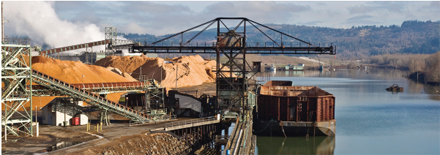A supply chain study of forestry in British Columbia, Canada has concluded that it’s not just rural sawmill towns that benefit from logging, sawmilling and pulp mills. The study, conducted by iTotem Technologies on behalf of the Council of Forest Industries (COFI), identified Can$7 billion worth of supply chain spending in BC, with about Can$2 billion going to 2100 businesses in the Metro Vancouver region, half of which went to Vancouver businesses providing goods and services. Source: BIV
One of the Vancouver companies providing services to the forestry sector is FYBR, which uses drones in providing assessments of wood fibre inventory.
“Our forest industry partners rely on our technology to provide accurate information to make forest and mill operations more efficient and sustainable,” said FYBR cofounder Michael Wilcox.
“Many people tend to associate the forest industry with rural areas and smaller communities, but this study shows that people working in businesses in urban centres like Vancouver, Surrey, Burnaby, Nanaimo and Kamloops also depend on a strong and vibrant forest industry supply chain,” COFI president Susan Yurkovich said. “This study clearly demonstrates how our forest industry’s deep roots are supporting workers and families right across our province.”
Outside of Vancouver, businesses in cities like Nanaimo, Prince George, Kamloops and Kelowna provide more than Can$1 billion in goods and services to forestry companies. Vancouver Island sees a large portion of the spending.
“On Vancouver Island, Can$1.2 billion worth of goods and services were purchased from 1600 suppliers, with more than a quarter of them located in Nanaimo,” the study finds.
“In the North, Prince George was home to 970 forestry suppliers that provided Can$718 million in goods and services. And more than 550 businesses from Kelowna and Kamloops in the Interior provided a combined $220 million of the forestry supply chain spend.
“In Port McNeill, 80% of our population of 2200 earns a living in some way from the forest industry,” said Port McNeil Mayor Gaby Wickstrom.
Forty companies in Port McNeill supplied Can$39 million in goods and services to the forestry sector last year.
“Many of those small businesses are key partners to the industry,” Ms Wickstrom said.
First Nations in BC receive about Can$250 million in economic benefits from forestry.
“Through our long-term relationship agreement with forest company Interfor, we are creating more jobs and opportunities for people in our community,” said Kelsie Robinson, band councillor for the Homalco First Nation.
“We’re also working together to access lumber from Interfor’s mills to support local infrastructure development, including new housing for community members.”
BC’s forest industry provides 100,000 direct and indirect jobs, COFI says, contributes nearly Can$13 billion to the provincial GDP and close to Can $4 billion annually in revenues to municipal, provincial and federal governments.
But it’s an industry that has been hammered by high stumpage rates, falling fibre supplies, and American softwood lumber duties. Several sawmills in BC have permanently shut down since mid-2019, and many more have curtailed production.
Based on platforms and pledges to date, it appears the major parties aren’t giving a whole lot of attention to forestry in the provincial election. Some of the attention it is getting isn’t the kind the industry wants.
Both the Green and NDP parties are pledging more regulations and measures that would shrink access to fibre even more.
The BC Liberals have not yet released their platform but have committed recently to introducing legislation that would protect working forests, and reform the stumpage system to something more market based.






